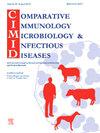Disclosing coinfections: The interaction between Toxoplasma gondii and hemotropic agents in Colombian dogs and cats
IF 2
3区 农林科学
Q4 IMMUNOLOGY
Comparative Immunology Microbiology and Infectious Diseases
Pub Date : 2025-07-18
DOI:10.1016/j.cimid.2025.102385
引用次数: 0
Abstract
This study aimed to analyze the relationships between Toxoplasma gondii infection and hemotropic species (i.e., Rickettsiales, Hepatozoon spp., Mycoplasma spp., Babesia spp., Bartonella spp., and Trypanosoma spp.) via qPCR and to explore the associations between T. gondii monoinfection or coinfection with hemotropic species and the characteristics of dogs and cats in Antioquia (Colombia). A cross-sectional study was conducted with blood samples from dogs and cats positive for T. gondii by qPCR, with or without hemotropic coinfection. Hemogram results and demographic data were analyzed. Associations with monoinfection/coinfection were tested via Fisher’s exact test or the ꭕ² test (p < 0.10). Among the 590 animals (383 dogs, 207 cats), 262 (44.4 %) tested positive for T. gondii (dogs: 175/262, 66.8 %; cats: 87/262, 33.2 %). Among the dogs, 73.7 % had coinfections, including Rickettsiales (101/129), Mycoplasma spp. (55/129), Hepatozoon spp. (9/129), Bartonella spp. (7/129), and Babesia spp. (2/129); none tested positive for Trypanosoma spp. Coinfections were associated with breed, outdoor access, reticulocytes, lymphocytes, or reproductive status. In cats, 72.4 % had coinfections: Bartonella spp. (40/63), Mycoplasma spp. (23/63), Rickettsiales (11/63), and Hepatozoon spp. (3/63). All the cats tested negative for Babesia spp. and Trypanosoma spp. Coinfections were associated with leukocyte, neutrophil, lymphocyte, and protein alterations. T. gondii is prevalent in dogs and cats, with frequent coinfections. Environmental and biological factors influence these patterns, underscoring the importance of integrated diagnostics and surveillance. These findings suggest associations that warrant further investigation.
揭露共感染:哥伦比亚犬猫刚地弓形虫与致血因子的相互作用
本研究旨在通过qPCR方法分析刚地弓形虫感染与立克次体、肝虫体、支原体、巴贝虫体、巴尔通体、锥虫体等嗜血性物种的关系,探讨哥伦比亚安蒂奥基亚地区刚地弓形虫单感染或共感染嗜血性物种与犬猫特征的关系。对经qPCR检测弓形虫阳性的狗和猫的血液样本进行了一项横断面研究,包括合并或不合并嗜血性感染。分析血象结果和人口统计数据。通过Fisher精确检验或ꭕ²检验(p <; 0.10)检验单感染/合并感染的相关性。590只动物(狗383只,猫207只)中,弓形虫阳性262只(44.4% %)(狗175/262只,66.8% %;猫:87/262,33.2% %)。73.7 %的犬共感染,包括立克次体(101/129)、支原体(55/129)、肝虫(9/129)、巴尔通体(7/129)和巴贝斯虫(2/129);同时感染与犬种、户外活动、网织红细胞、淋巴细胞或生殖状态有关。在猫中,72.4 %共感染巴尔通体(40/63)、支原体(23/63)、立克次体(11/63)和肝虫(3/63)。所有猫的巴贝斯虫和锥虫检测均为阴性,合并感染与白细胞、中性粒细胞、淋巴细胞和蛋白质改变有关。弓形虫在狗和猫中普遍存在,经常发生合并感染。环境和生物因素影响这些模式,强调了综合诊断和监测的重要性。这些发现表明有必要进行进一步的调查。
本文章由计算机程序翻译,如有差异,请以英文原文为准。
求助全文
约1分钟内获得全文
求助全文
来源期刊
CiteScore
4.60
自引率
0.00%
发文量
102
审稿时长
40 days
期刊介绍:
Comparative Immunology, Microbiology & Infectious Diseases aims to respond to the concept of "One Medicine" and to provide a venue for scientific exchange. Based on the concept of "Comparative Medicine" interdisciplinary cooperation between specialists in human and animal medicine is of mutual interest and benefit. Therefore, there is need to combine the respective interest of physicians, veterinarians and other health professionals for comparative studies relevant to either human or animal medicine .
The journal is open to subjects of common interest related to the immunology, immunopathology, microbiology, parasitology and epidemiology of human and animal infectious diseases, especially zoonotic infections, and animal models of human infectious diseases. The role of environmental factors in disease emergence is emphasized. CIMID is mainly focusing on applied veterinary and human medicine rather than on fundamental experimental research.

 求助内容:
求助内容: 应助结果提醒方式:
应助结果提醒方式:


